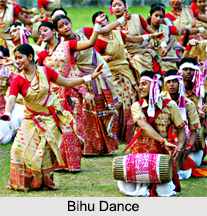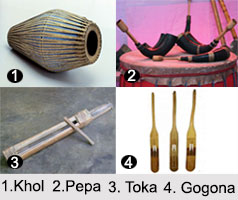 Bihu Dance is a popular folk dance related with the state of Assam in India and it is performed commonly in the Bihu festival. There are three types of Bihu festivals that are popular in Assam namely Rongali Bihu, Kongali Bihu and Bhogali Bihu and the Bihu dance is performed in the Rongali Bihu. There are lots of contemporary forms of this dance. Some of them are Bihu deori, Bihu missing, etc.
Bihu Dance is a popular folk dance related with the state of Assam in India and it is performed commonly in the Bihu festival. There are three types of Bihu festivals that are popular in Assam namely Rongali Bihu, Kongali Bihu and Bhogali Bihu and the Bihu dance is performed in the Rongali Bihu. There are lots of contemporary forms of this dance. Some of them are Bihu deori, Bihu missing, etc.
This happy dance is performed by both young men and women, and is characterized by fast dance steps, swift hand movement and a musical significant of the body movement in order to represent young passion.
Origin of Bihu Dance
The features regarding the origin of Bihu dance is not known but has been very significant in the cultures of many Assamese ethnic groups like the Deoris, Sonowal Kacharis, Chutias, Moran and Borahis. Though as per the records, the first ever Bihu dance was performed when Ahom King Rudra Singha requested the dancers to perform Bihu in the year of 1694 at Ranghar fields on the joyous occasion of Rongali Bihu. The festival of Rongali Bihu is celebrated in middle of April and both men and women take part in a rhythmic celebration called Bihu dance. The style of Bihu dance is sole in every sense of the word. Basically, the word Bihu is the Assamese term for marking the onset of the harvest season or the Assamese New Year. It is an eagerly awaited festival and is one of the biggest festivals in Assamese culture involving a lot of indigenous display of song dance and merry making.
 Costumes of Bihu Dance
Costumes of Bihu Dance
The lively dance steps of Bihu and the quick hand movements describe the Bihu dance of Assam. This folk dance of Assam is performed generally by the young males and females to demonstrate their joy and happiness on the arrival of spring season. A lot of liveliness can be seen in the dance outfit of Bihu and that is what portrays the authentic spirit of this dance form.
The male performers of Bihu dance are dressed in dhotis and gamocha. Gamocha is for the head, and both the dhoti and the gamocha are bright in colours and have beautiful needlework in different styles and patterns on the two ends. The women dancers usually wear the traditional clothing for the performance. They are dressed in Chador and Mekhela. Mekhela, a traditional costume of Assam is cylindrical in shape and is worn on the lower half of the body. Chador on the other hand is like a dress which is used for covering up the upper portion of the body. The women dancers wear a blouse under the chador and the common fabrics used for making the garments are pat silk, cotton and muga silk. Women team up their outfits with colourful and heavy jewellery and they also decorate their braids with beautiful flowers that completely match the colour of the attire worn by them.
Musical Instruments of Bihu Dance
There are many musical instruments that are utilized during a Bihu performance namely a khole, pepa, taal, toka, which is a type of jaw harp and xutuli, gogona and baanhi.
Bihu dance is performed for the most part during the time after the completion of harvest and the festivities carry on for a month. A traditional Bihu performance is eye catching and worth cherishing as it recites the happiness and heritage of the Assamese people. Of late, the level of popularity of Bihu dance is such that it was performed by a professional dance group at the occasion of London Olympics in the year 2012.




